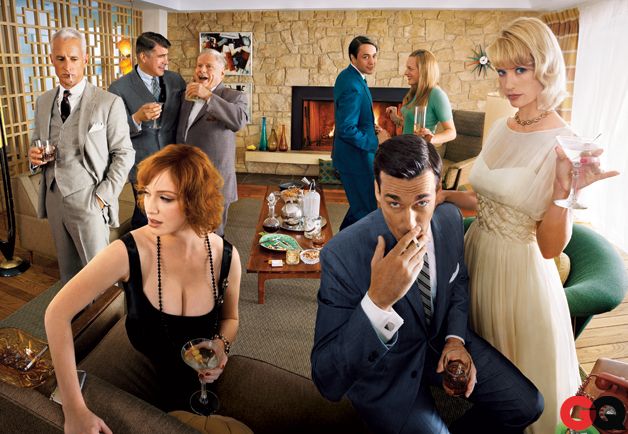For the larger party comprising people who may not know others, the host and hostess have to play a more active part; it is advisable, therefore, to have help at the bar if possible, and in the kitchen, too, if hot hors d'oeuvres are planned. The food, small in portion, should never be sweet; usually it is highly seasoned or is made up of such items as anchovies, sharp cheese, and olives. Good drinks, good food, compatible company, and sufficient room to circulate are the requisites for a good cocktail party.
For the really large affair, held when the main meal is eaten in the middle of the day and the guests may be coming some distance, a buffet is necessary. The menu can be simple, but hearty enough to substitute for a meal, with food that will keep fresh over the period of the party. A well-balanced plan would include one or more hot dishes, as well as cold meats, cheeses, relishes, a spread, and a variety of food that can be eaten with the fingers.
COCKTAIL PARTY CHECKLIST
INVITATIONS—
Mail or phone. The time is usually somewhere between 5 and 8 P.M. up less it is a come-when-you-can and stay-as-long-as-you-like buffet plan.
MUSIC—
MUSIC—
Some find this helpful as a background, particularly at the beginning of a party, but many people find it disturbing. Ashtrays should be large and plentiful. If arrangements can be made to have them emptied regularly, so much the better. For tables that do not have an alcohol-proof finish, a liberal supply of coasters should be available. Place small tables next to chairs so that guests can sit down with their drinks.
GLASSES—
GLASSES—
It is good to have on hand twice as many as your guest list.
ICE CUBES– Start freezing these at least a day ahead, to fill ice buckets, or else buy the cubes in quantity. Use only fresh ice for old ice absorbs tastes and odors.
FOOD—
FOOD—
Many foods can be prepared well ahead and sealed in airtight wrapping for the refrigerator or freezer.
NAPKINS, SERVIETTES, AND HAND TOWELS—
NAPKINS, SERVIETTES, AND HAND TOWELS—
Have plenty of the gay paper cocktail napkins on the food and drink tables and an extra supply in reserve. Hand towels of soft absorbent paper, which seem to be preferred to dainty linen ones, should be well supplied in all bathrooms and powder rooms.
COCKTAILS—
COCKTAILS—
Follow a tested recipe and use a jigger for measuring, unless you are an expert guesser. Stir, rather than shake, all drinks made with clear liquors, such as Martinis or Manhattans. Martinis can be made somewhat in advance and placed in a refrigerator. The ice is added later so that the cocktail is not diluted. Shake all cocktails that contain ingredients which are harder to blend, like Daiquiris, Bloody Marys, and whisky sours. Pre-chill the glasses – this makes a big difference. Use lots of ice – but never twice. There is nothing worse than a lukewarm drink that was meant to be cold. For drinks like a Tom Collins, as a rule, sugar, fruit juice, and ice are put in the glass first, and then liquor is added. For a carbonated drink, like a gin and tonic, add ice, liquor, then the mix.
For those who do not like cocktails there are many alternatives, besides the traditional serving of whisky or sherry. Punch and eggnog are two favorites, and if you do not have your own recipes for these, any good liquor or wine shop will provide you with them. You might try a “cheese and wine” party, or make this a part of a cocktail party. Cheeses should be eaten with the fingers or with the aid of toothpicks.
For those who do not like cocktails there are many alternatives, besides the traditional serving of whisky or sherry. Punch and eggnog are two favorites, and if you do not have your own recipes for these, any good liquor or wine shop will provide you with them. You might try a “cheese and wine” party, or make this a part of a cocktail party. Cheeses should be eaten with the fingers or with the aid of toothpicks.
The food, with plates and napkins, and the cocktail equipment, can be set on one table. But it is better to have the bar set up on a separate table with plenty of room for service, as guests usually like to drink for a while before eating. If you have a barman, he can take orders and serve everything from the kitchen or pantry. Coffee should be ready in the kitchen, since it may be needed later in the evening.— From “Table Settings, Entertaining and Etiquette,” by Patricia Easterbrook, 1960
🍽 Etiquette Enthusiast, Maura J Graber, is the Site Editor for the Etiquipedia© Etiquette Encyclopedia

No comments:
Post a Comment
Note: Only a member of this blog may post a comment.